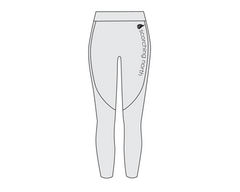
Over recent years more and more horse riders are choosing to wear riding tights (riding leggings) instead of traditional breeches or jodhpurs. Lots of people have asked us what the difference is, and whether riding tights could be a good option for them? Well, here is our guide to riding tights, what to look for, and why you should choose them.
The basics
First and foremost riding tights are designed to be pull-on, that means they don’t have a button or zip. There is a reason for that (see later section) but fundamentally that is the only real difference between tights and breeches/jodhpurs. Now you might be thinking, hang on, riding tights always feel different to breeches, and you are right, but for the most part this is because of decisions that are made by manufacturers (like us) to offer you a product that is different to traditional riding gear.
The fabrics
The idea for riding tights came from the increased popularity of sports wear leggings/tights across many sports including running, yoga and cycling. Over the past few decades there have been great advances in the manufacture of technical stretch fabrics. These fabrics have gotten more varied, harder wearing, antimicrobial and anti-stain treated, moisture wicking/wind proofing and now come in many colours and weights. Along with this, advances in printing processes have made technical stretch fabrics the most popular materials for all sportswear globally because of the colours and patterns that can be as varied as your imagination.
 When manufacturing riding wear from technical stretch fabrics several benefits are immediately apparent, and it is all about comfort. Most riding tights will be made from 4-way stretch fabrics. This means that they stretch both wide and tall. Importantly the fabrics also stretch A LOT which means that as long as the product matches your hip measurement you are likely to find them comfortable everywhere else and long enough in the leg.
When manufacturing riding wear from technical stretch fabrics several benefits are immediately apparent, and it is all about comfort. Most riding tights will be made from 4-way stretch fabrics. This means that they stretch both wide and tall. Importantly the fabrics also stretch A LOT which means that as long as the product matches your hip measurement you are likely to find them comfortable everywhere else and long enough in the leg.
Why is this different to breeches?
Traditional breeches are made from cotton/suede and more recently heavy-duty synthetic blends. Most of these fabrics have limited 2-way stretch at best. What this means is that it is the cut and design of the breeches will dictate whether you find them comfortable or not. Just because they fit your hips doesn’t mean they will fit your legs or waist. It is this limited stretch that causes all breeches and jodhpurs to need a button/fly.  Women have on average a hip to waist ratio of about 0.8 and many have a ratio under 0.7; what this means is that the waist band of your breeches has to stretch at least 45% to make sure you can pull them over your hips. Most breeches just can’t stretch this much and so they put a button/zip in the design to solve the problem. This amount of stretch is nothing for the fabrics that are used in riding tights and so the button/zip just isn’t needed. If you want to buy a pair of breeches we would always suggest 1) Find a cut that matches your curves and 2) Always try them on before buying.
Women have on average a hip to waist ratio of about 0.8 and many have a ratio under 0.7; what this means is that the waist band of your breeches has to stretch at least 45% to make sure you can pull them over your hips. Most breeches just can’t stretch this much and so they put a button/zip in the design to solve the problem. This amount of stretch is nothing for the fabrics that are used in riding tights and so the button/zip just isn’t needed. If you want to buy a pair of breeches we would always suggest 1) Find a cut that matches your curves and 2) Always try them on before buying.
What about durability?
Durability varies massively across both riding tights and breeches for certain BUT the heavy-duty materials that can be used for breeches means that for extreme durability nothing will beat a button/fly design. Materials such as leather, denim and nylon are extremely hard wearing and if you are looking for something that will last for years then a tailored pair of heavy-duty breeches is hard to beat. Of course, that doesn’t mean that you cannot have hard wearing riding tights, but you have to know what you are looking for. For tights, it is all about the material weight, usually measured in grams per square metre (GSM).
Most riding tights are made from knitted blends of similar synthetic microfibers. For the most part this means that the heavier the weight of the material the more durable it is likely to be. Riding tights do vary in weight however depending on whether they are designed for summer or winter riding. We recommend a minimum of 280GSM for summer riding and above 300GSM for cool weather riding. For comparison, your cheap supermarket yoga tights might be as low as 160GSM and your running tights might be around 260GSM.

What about my lumps and bumps?
We often get customers concerned about how riding tights might highlight their…less than flattering attributes. Fair enough, we cannot guarantee perfection but we can suggest two simple rules if this is a concern for you.
Rule 1: The heavier the weight the better the hold. If you choose a heavier material, you are less likely to see lumps and dimples.
Rule 2: Don't squeeze into a smaller size just because you can.The more riding tights stretch, the thinner they become (and also less durable).
Rule 3: Hide the shadows with darks and patterns. Lumps and dimples are only seen as shadows, dark matt finishes and patterns (like these ♥) prevent them catching the eye.
In the end…
For most people a good pair of riding tights is a great addition to their riding wardrobe. The comfort and easy care that comes with a 4-way stretch pair of tights makes them perfect for every day use. Just throw them in the wash when you get home and they will dry on a hanger in a few hours. They won’t last forever, but for most people the convenience of easy wash/dry and comfort for everyday riding makes them a great choice that is becoming more popular every year.
